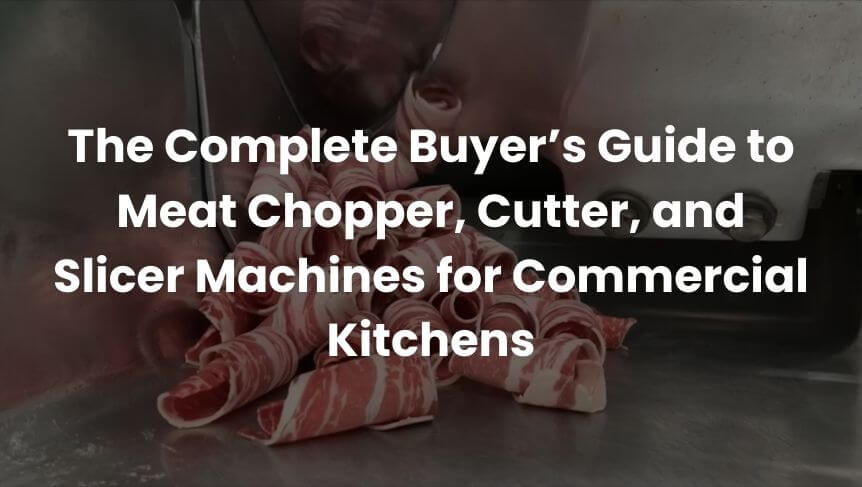If you run a busy commercial kitchen, you already know that speed and precision are everything. Whether it’s prepping meats for sandwiches, stir-fries, or burgers, the right equipment makes a huge difference.
Meat chopper, cutter, and slicer machines help you save time, reduce labour, and keep every portion consistent. But with many options in the market, how do you choose the right one?
This guide explains the key differences between chopper, cutter, and slicer machines. You’ll learn what to look for when buying, how to maintain your machine, and which option fits your kitchen best. We’ve also included why Hubs is a trusted name in the industry and how storage plays a role in your setup.
Chopper, Cutter and Slicer Machines: What Sets Them Apart
Not all machines are made the same. Each one plays a different role in a commercial kitchen. Let’s break it down.
Meat Chopper Machine
A meat chopper machine is mainly used to grind and mince raw meat. It’s the best choice if your kitchen prepares burger patties, sausages, or minced fillings.
Choppers work by using blades or plates to crush meat into fine or coarse textures. They can handle bones and tendons too, depending on the model. These machines are heavy-duty and made for high-volume use.
They’re often seen in butcher shops, catering businesses, and factory kitchens. If your menu needs a lot of ground meat, this is the machine to get.
If ground meat is a daily need, investing in a high-quality meat chopper machine is a smart move.
Meat Cutter Machine
The meat cutter machine is all about flexibility. It slices, dices, and chops meat into pieces for soups, stir-fries, skewers, and curries.
Unlike the chopper, a meat cutter allows more control over the size and shape of the cut. Some models let you switch blades for different styles.
Cutter machines are perfect for busy restaurants or food prep teams. They reduce manual cutting time and produce even pieces, helping food cook evenly and look better on the plate.
Meat Slicer Machine
The meat slicer machine is used for clean, even cuts of cooked or cold meat. Think roast beef, ham, or deli meats. It’s a must-have in sandwich shops, cafes, and hotels.
Most commercial meat slicer models have an adjustable blade to control how thick or thin the slices are. Some are manual, while others are automatic for higher output.
This machine ensures you get consistent slices without tearing or waste. It keeps your portions exact and helps reduce food cost.
Top Features to Look For in a Meat Processing Machine
Buying the right meat processing machine Malaysia means knowing what matters most. Here are the top things to look for.
Strong Build
Always go for stainless steel. It’s easy to clean, lasts long, and handles daily use without rusting or bending. Plastic parts wear out fast in commercial use.
Safety First
Machines should have guards, non-slip feet, and stop switches. Good brands also follow pallet racking safety rules to keep your staff safe while using and storing machines.
Power That Matches Your Need
Motor strength affects speed and capacity. High-watt machines process meat quicker and in larger batches. Choose based on your kitchen’s daily meat output.
Easy to Clean
Pick machines that come apart easily. Smooth surfaces without cracks help prevent meat buildup and bacteria. Make sure they’re simple to wash and reassemble.
Interchangeable Blades
Some cutters and slicers offer blade sets for different types of cuts. This is helpful if you prepare a wide range of dishes.
Noise Levels
Look for machines that run quietly, especially if your kitchen is small or open-plan.

Which Machine Is Right for Your Business?
Choosing between a chopper, cutter, or slicer depends on what you cook most.
- If you need ground meat every day, go for a meat chopper machine
- If your menu includes diced or shredded meats, a meat cutter machine is ideal
- If you need neat slices for cold dishes or sandwiches, a meat slicer machine will do the job
Some kitchens might need more than one machine. Think about your peak hours and how much meat prep happens daily. Planning ahead helps avoid machine overload.
Also, think about space. Machines should fit your kitchen layout. This is where good factory storage and pallet racking come in. Proper racking prevents clutter and keeps machines secure when not in use.
Why Hubs Is a Trusted Supplier in Malaysia
If you’re looking for reliable food processing equipment, Hubs delivers.
Focus on Quality
Hubs supplies only high-grade machines designed for commercial kitchens. Their equipment goes through strict checks before reaching your kitchen.
Great Support
Need help picking a machine? Hubs doesn’t just sell equipment—they offer guidance. They’ll recommend the right model based on your kitchen size, menu, and budget.
Storage Experts Too
Besides machines, Hubs is a top pallet rack supplier. They understand how storage fits into your kitchen. Their team also offers warehouse racking systems to help you store machines safely and within reach.
Tailored for Your Business
Whether you’re running a small cafe or a large kitchen with a Heavy Duty Rack setup, Hubs has machines and racks to match your needs. That makes them a one-stop solution for restaurant equipment and storage.

How to Maintain Your Meat Machine
Buying a good machine is only the start. Keeping it in top shape will save you money and prevent breakdowns. Follow these easy tips.
Clean It Every Day
Wipe the machine after each use. Remove parts and wash them in warm, soapy water. Avoid harsh scrubbers. Dry everything fully before putting it back.
Oil the Moving Parts
Blades, gears, and shafts need oiling now and then. Use food-safe oil to keep them smooth and reduce wear.
Keep Blades Sharp
A blunt blade makes the motor work harder and gives poor cuts. Use a blade sharpener or get it serviced by a pro.
Store It Safely
When not in use, machines should sit on a strong shelf or rack. A stable industrial pallet rack Malaysia option from Hubs can keep it safe from knocks and spills.
Get it Serviced
Set reminders to check your machine monthly. Look for worn wires, loose bolts, or odd noises. Fixing small issues early avoids big repairs later.
Conclusion
Choosing the right meat machine isn’t just about price. It’s about knowing your kitchen’s needs and picking equipment that lasts, works fast, and keeps your team safe.
A meat chopper is great for grinding and mincing. A meat cutter handles dicing and chopping. A meat slicer makes neat, even cuts. Each one helps your team work faster and serve better food.
Look for machines that are strong, easy to clean, and safe to use. Plan how you’ll store them good storage helps prevent damage and saves space. A trusted pallet rack supplier like Hubs can offer racks that fit your kitchen and your machine size.
With the right tools and a bit of care, your kitchen will run smoother than ever.


